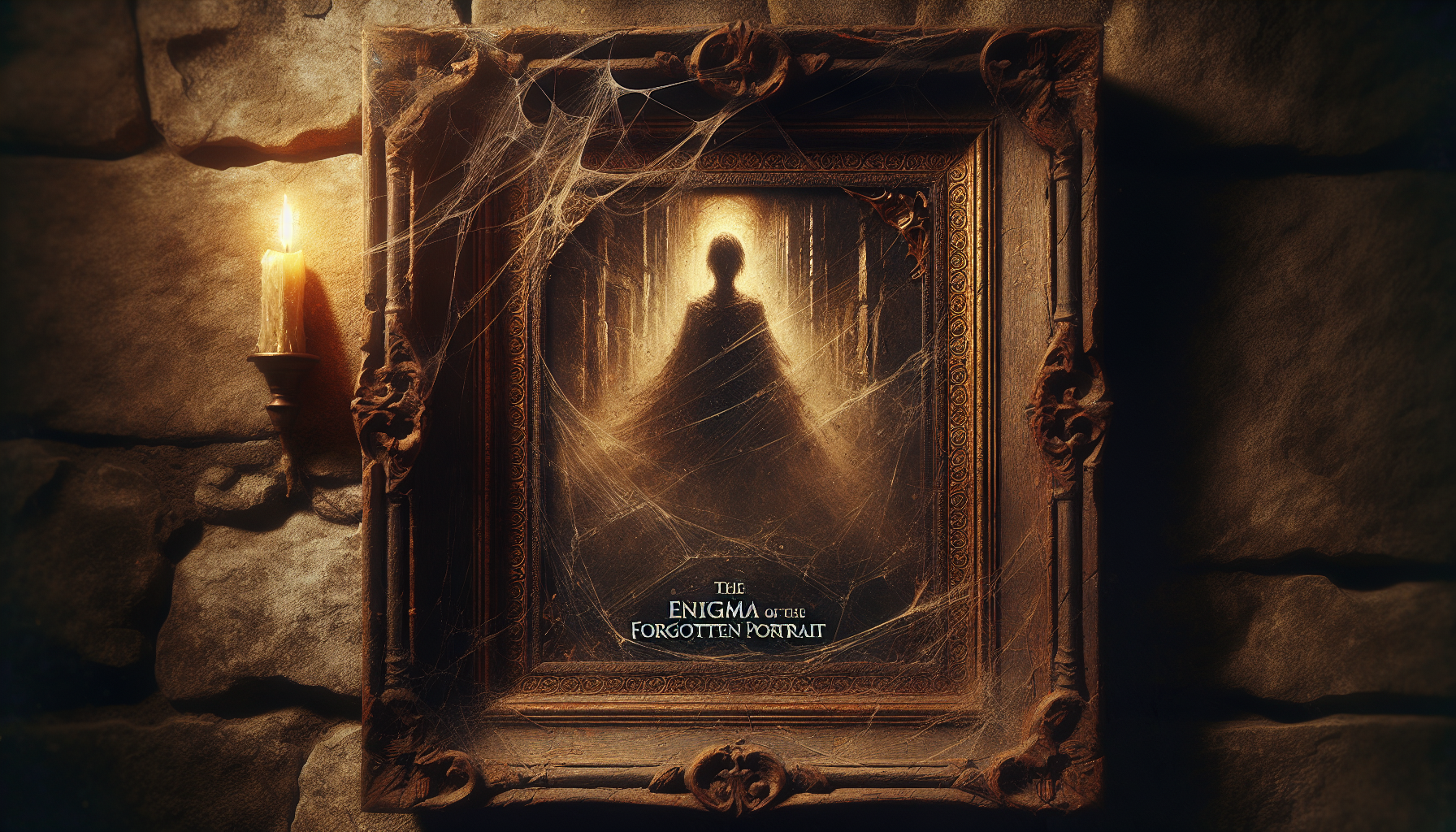Chapter 1: The Arrival
In the quiet, mist-laden village of Eldergrove, there stood an antiquated manor known as Greywood Hall. The manor had long been rumored to harbor secrets hidden within its aging walls. It was to this very place that Jonathan Reed, a young historian with a penchant for solving mysteries, found himself summoned one blustery autumn afternoon.
The summons had come unexpectedly, in the form of a tattered envelope bearing an unfamiliar seal. Inside was a letter from an old acquaintance, Lady Margaret Ainsworth, pleading for Jonathan’s expertise in unraveling a perplexing mystery that had recently come to light.
As Jonathan approached the manor, the wind howled through the gnarled trees lining the driveway, and the leaves danced wildly in a chaotic ballet. Greywood Hall loomed ahead, its façade a testament to a bygone era, with ivy clinging stubbornly to its stone walls and windows that seemed to gaze upon the world with haunted eyes.
Upon reaching the massive oak doors, Jonathan paused to gather his thoughts. He knocked firmly, his mind already racing with possibilities. The door creaked open, and he was greeted by the stoic visage of Mrs. Abernathy, the housekeeper.
Welcome, Mr. Reed. Lady Ainsworth is expecting you in the drawing-room, she announced, stepping aside to allow him entry.
The interior of Greywood Hall was a labyrinth of dimly lit corridors adorned with portraits of stern ancestors, their eyes following him with an unsettling intensity. Jonathan couldn’t shake the feeling of being watched as he made his way to the drawing-room.
Lady Margaret was seated by the hearth, her greying hair pulled back in a tight bun, her sharp blue eyes reflecting a lifetime of wisdom and perhaps a trace of worry. Jonathan, thank you for coming, she said, gesturing for him to sit. We have much to discuss.
As Jonathan settled into the armchair opposite Lady Margaret, he noticed a peculiar painting above the fireplace—a portrait of a young woman dressed in Victorian attire. Her expression was serene, yet there was something enigmatic about her gaze, as though she held secrets of her own.
Lady Margaret followed his gaze and nodded. That’s the portrait, she said softly, the one that has caused all this confusion. It was discovered recently in the attic, behind a false wall, and nobody knows who she is or why she’s here.
Intrigued, Jonathan leaned forward. Tell me everything, Lady Margaret. I’m here to help unravel this enigma.
With a nod, Lady Margaret began to recount the history of Greywood Hall and the mysterious circumstances surrounding the portrait.
Chapter 2: The Secret in the Attic
The tale began in the early 1800s when Greywood Hall was first constructed by the eccentric Lord Edmund Greywood. Known for his love of art and the occult, he had filled the manor with artifacts from around the world. Over the generations, the family had expanded the estate, adding secret passages and hidden rooms that only the Greywoods and their trusted confidants knew about.
The portrait, Lady Margaret explained, had been discovered by accident. During a routine inspection of the manor’s rafters, a worker had stumbled upon a concealed door behind a stack of old crates. Behind this door lay a small, dust-covered room, and within it hung the portrait, untouched by time.
Nobody in the village or amongst the current staff recognized the woman in the painting. There were no records of her within the family archives, nor any mention of her in the local historical society’s documents. It was as though she had been deliberately erased from history.
Jonathan listened intently, his mind piecing together the fragments of the story. The secrecy surrounding the portrait suggested it was more than a mere forgotten artwork. There was a reason it had been hidden away, and Jonathan was determined to uncover it.
Can I see the room where it was found? he asked, eager to begin his investigation.
Lady Margaret nodded. Of course. Mrs. Abernathy will show you the way. She’s been with the family for decades and knows this house better than anyone.
Mrs. Abernathy reappeared, her expression as inscrutable as ever. If you’ll follow me, Mr. Reed, she instructed, leading him through the manor’s winding corridors.
The path to the attic was a journey through time. Each step up the creaking staircase seemed to echo with memories of those who had walked before. At last, they reached the attic door, its wood weathered and worn by years.
Mrs. Abernathy opened the door, revealing a space filled with dust motes dancing in the shafts of light filtering through the narrow windows. She pointed to the spot where the portrait had been found, and Jonathan moved closer, examining the area with a keen eye.
The room was small and unremarkable, yet Jonathan felt a shiver of excitement. There was an aura of mystery here, a sense of stories untold. He ran his fingers along the walls, searching for any clues that might have been overlooked.
As he did, his hand brushed against something cold and metallic—a latch, cleverly hidden beneath layers of dust and grime. With a click, a small compartment in the wall swung open, revealing a stack of yellowed letters tied with a faded ribbon.
Jonathan’s heart quickened. Here, perhaps, lay the key to the enigma of the forgotten portrait. He carefully untied the bundle and began to read, his pulse pounding with the anticipation of discovery.
Chapter 3: The Letters
The letters were penned in a delicate script, the ink faded with age but still legible. They revealed a correspondence between two individuals, their identities obscured by the use of initials. The first letter was dated June 15th, 1843, and began with an expression of longing and affection.
Dearest A, it read, I find myself consumed by thoughts of you. Each day feels endless until we are reunited. Your portrait is all that brings me solace in your absence.
Jonathan’s curiosity was piqued. Here was a mention of a portrait, one that appeared to hold significant sentimental value. As he read on, the letters unfolded a poignant tale of love and secrecy. The two correspondents were clearly in the throes of a passionate romance, yet there were hints of an obstacle that stood between them.
In one letter, the writer lamented, Our love is a flame that burns brightly, yet shadows linger around us. We must be cautious, for the world would never understand. I keep your likeness hidden, a treasure known only to my heart.
The final letter in the collection was dated September 3rd, 1843, and it was marked by an air of desperation.
My beloved A, the letter began, I fear that our time together is running out. I have made arrangements to leave, but we must be careful. Trust no one, and guard our secret well. Until we meet again, know that my love for you is eternal.
With these words, the correspondence abruptly ended, leaving Jonathan with more questions than answers. Who were these mysterious lovers, and what had driven them into hiding? Could the woman in the portrait be the enigmatic A mentioned in the letters?
As Jonathan pondered these mysteries, he heard a soft footfall behind him. He turned to see Lady Margaret standing in the doorway, her expression one of quiet curiosity.
Have you found something, Jonathan? she asked, her eyes drifting to the letters in his hand.
Jonathan nodded, sharing the contents of the letters with her. Lady Margaret listened intently, her brow furrowing as she absorbed the tale.
It seems we have uncovered a love story concealed by time, she mused. But the question remains—why was it hidden so carefully? And what became of these two lovers?
Jonathan couldn’t help but agree. The letters had opened a window into the past, but they had also cast a shadow of intrigue over the present. There was more to this mystery than met the eye, and he was determined to see it through to the end.
Chapter 4: Shadows of the Past
With the letters as their only clue, Jonathan and Lady Margaret set about delving deeper into the history of Greywood Hall. The task was daunting, for the passage of time had eroded much of the documentation pertaining to the estate’s earlier years. Nevertheless, their determination was unwavering.
Lady Margaret suggested they start with the family archives, a collection of ledgers and journals stored in the manor’s library. The room was an impressive chamber lined with shelves that stretched from floor to ceiling, filled with books of every conceivable subject.
As they began their search, Jonathan found himself drawn to a particular journal bound in cracked leather. The cover bore the name Lord Edmund Greywood, and it was dated to the early 1840s. With a sense of anticipation, he opened it and began to read.
The journal entries painted a vivid picture of Lord Greywood’s life, his passions, and his eccentricities. It became clear that he was indeed the kind of man who would build secret rooms and passageways within his home. More intriguingly, there were several mentions of an artist named Amelia, who had been commissioned to paint a series of portraits for the manor.
Could this Amelia be the mysterious A from the letters? Jonathan wondered aloud, showing the journal to Lady Margaret.
It’s certainly possible, she agreed. If she was the artist, it would make sense for her to create a portrait that held personal significance. But what about the other person in the letters? The one she corresponded with?
Jonathan flipped through the pages, hoping to find more clues about Amelia and her connection to the Greywood family. His perseverance was soon rewarded when he stumbled upon an entry dated August 12th, 1843.
Today, Amelia completed the final portrait, and I must admit, her talent is remarkable. However, I have grown concerned about her frequent meetings with my younger brother, Charles. There are whispers among the staff, and it would be disastrous if a scandal were to erupt. I must ensure discretion is maintained at all costs.
Jonathan paused, his mind racing. Could Charles Greywood be the other correspondent in the letters? If so, it would explain the need for secrecy and the urgency in their words.
Lady Margaret leaned in, her eyes alight with interest. We must find out what happened to Charles and Amelia. If their love was indeed forbidden, perhaps it led to a tragic end?
The possibility hung heavy in the air, casting a somber pall over their discovery. Yet Jonathan felt a renewed sense of purpose. They were closer to understanding the enigma of the forgotten portrait, and with persistence, the truth would soon be revealed.
Chapter 5: Uncovering the Truth
Determined to uncover the fates of Charles and Amelia, Jonathan and Lady Margaret continued their investigation with renewed vigor. They scoured local historical records, interviewed elderly villagers who might hold fragmentary memories of the past, and consulted genealogical registries.
Their efforts were rewarded when they stumbled upon an article in the Eldergrove Gazette, dated October 1843. It was a brief notice regarding the sudden disappearance of Charles Greywood, which had occurred under mysterious circumstances. The article speculated that he had left the village for personal reasons, but offered no further details.
Intrigued, Jonathan delved deeper into Charles’ background. He discovered that Charles had been a vibrant young man, well-liked but prone to defying societal norms. It seemed plausible that his love affair with Amelia had prompted his departure.
But what about Amelia? Jonathan wondered, searching for any mention of her in the records. After days of diligent research, he finally found a reference to an Amelia Laurent, an artist of considerable skill, who had once resided in Eldergrove. Her name appeared in an art exhibition catalog from 1842, but after that, she seemed to vanish from public records.
Frustrated by the lack of information, Jonathan decided to visit the Eldergrove Historical Society, hoping that their archives might hold the missing pieces of the puzzle. The society’s archivist, an elderly gentleman named Mr. Hayes, welcomed him warmly.
Ah, Greywood Hall, that place has always been shrouded in mystery, Mr. Hayes remarked, his eyes twinkling with interest. What brings you here today?
Jonathan explained the situation, sharing what he and Lady Margaret had uncovered so far. Mr. Hayes listened intently, then nodded thoughtfully.
You’re looking for the story of Charles and Amelia, he mused, tapping his chin. I believe there might be something in our private collection, a diary donated by a former maid of Greywood Hall. It mentions a rumored romance between Charles and an artist. Let me fetch it for you.
Jonathan waited with bated breath as Mr. Hayes disappeared into the back room. When he returned, he was carrying a small, leather-bound volume. This is it, Mr. Reed. Perhaps it will provide the insights you seek.
With gratitude, Jonathan accepted the diary and began to read. The entries were written in a familiar, flowing script, filled with accounts of daily life at the manor. Then, buried within the mundane, he found a passage that sent a chill down his spine.
October 10th, 1843. This evening, I overheard a conversation between Lord Edmund and Master Charles. There was anger in the air, and words were exchanged in haste. It seems Master Charles’ heart belongs to Miss Amelia, and Lord Edmund is determined to put an end to it. I fear for what may come.
The entry confirmed Jonathan’s suspicions of a family feud over the forbidden romance. He continued to read, his heart heavy with anticipation for a resolution to their story.
Chapter 6: The Final Revelation
Jonathan and Lady Margaret reconvened in the library of Greywood Hall, both eager to share their findings. As they pieced together the information, a clearer picture of the past began to emerge. It seemed that Charles Greywood and Amelia Laurent had indeed shared a deep and passionate love, one that had been thwarted by Lord Edmund’s disapproval.
The diary entries pointed to a confrontation between the brothers, which had likely led to Charles’ abrupt departure from Eldergrove. But what about Amelia? Jonathan wondered aloud. Why is there no mention of her fate?
Lady Margaret shook her head, her expression pensive. Perhaps she was forced to leave as well, or maybe she remained hidden away, her story lost to time.
Determined to find closure, Jonathan revisited the attic where the portrait had been found. He inspected every inch of the room, hoping to discover a hidden compartment or another cache of letters. As he examined the back of the portrait itself, he noticed something unusual—a corner of the canvas seemed slightly detached from its frame.
Carefully, he pried it open, revealing a small, folded note concealed within. His hands trembled as he unfolded the fragile paper, the words penned in a hurried script.
To whomever finds this, it began, know that our love was true, and though the world sought to tear us apart, our souls are forever entwined. I have left Eldergrove to seek a life where our love can flourish without fear. If you read this, remember us not for what was lost, but for what we dared to dream.
The note was signed simply with an A, and Jonathan felt a wave of emotion wash over him. Here, at last, was Amelia’s final message—an affirmation of love that survived even the darkest of times.
He shared the note with Lady Margaret, who read it with a wistful smile. They may not have had their happy ending, but they found a way to preserve their love, she reflected, her eyes misty with sentiment.
Jonathan nodded, feeling a sense of peace settle over him. The enigma of the forgotten portrait had been resolved, and though the story was bittersweet, it was a testament to the enduring power of love.
As he prepared to leave Greywood Hall, Jonathan took one last look at the portrait. The woman gazed back at him, her expression serene, as if she knew that her secret had finally been revealed. He felt a connection to her and to Charles, a bond forged through the passage of time.
With a sense of fulfillment, Jonathan bid farewell to Lady Margaret and the manor that had sheltered so many stories. He knew that the memory of Charles and Amelia would live on, their love an eternal enigma that had finally come to light.



